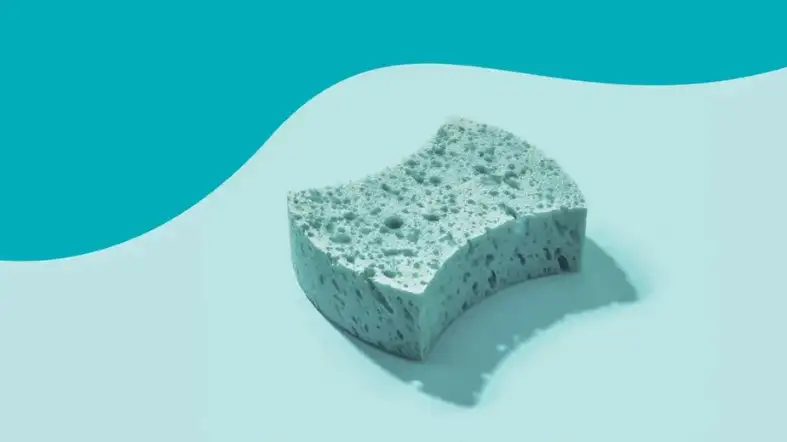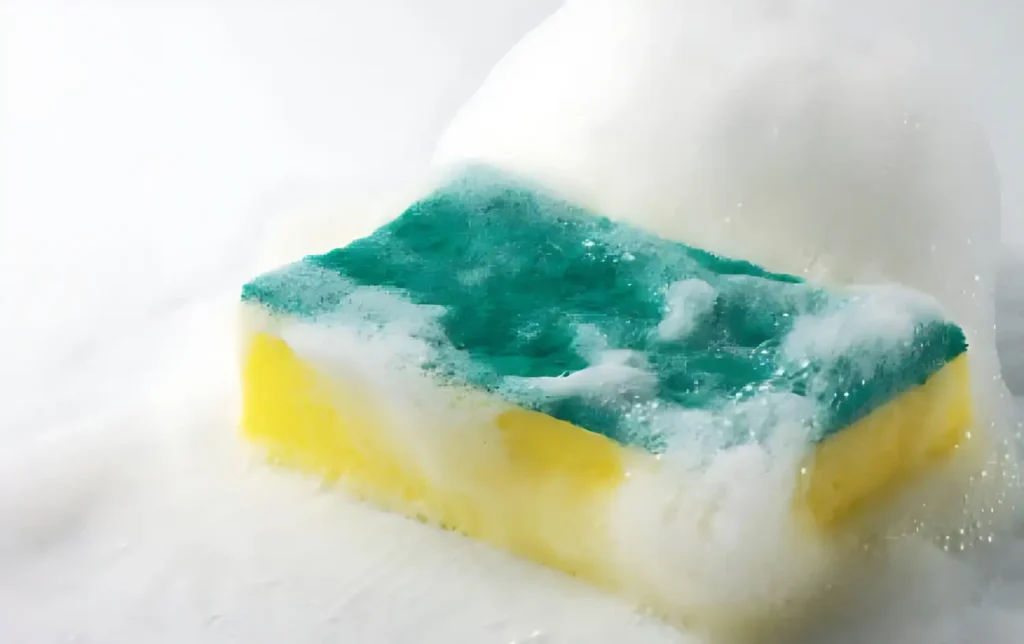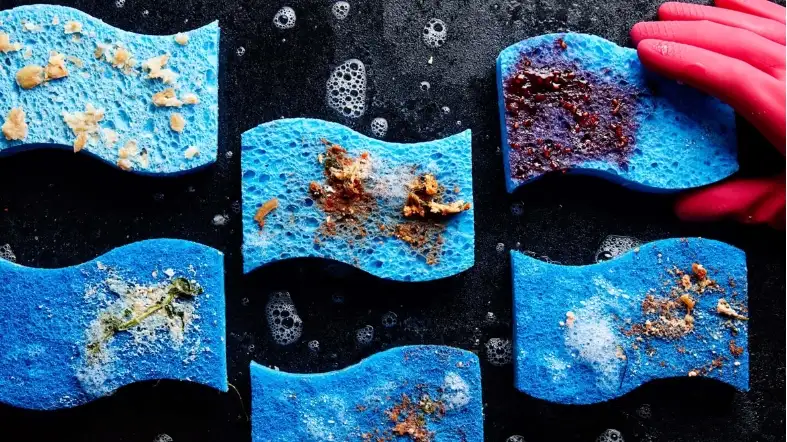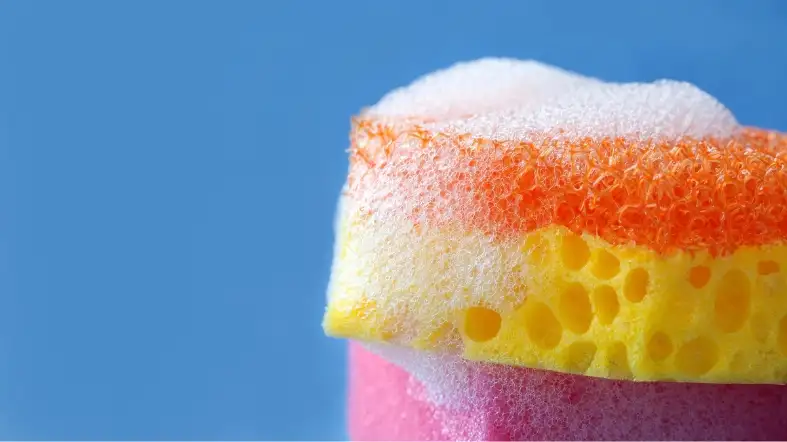Have you ever wondered whether it’s better to microwave or dishwasher sponges?
With conflicting online information, it’s no wonder that people are confused about the best way to clean their sponges. Keep learning more to find out.
Is It Better To Microwave Or Dishwasher Sponges?
Research has shown that microwaving a damp sponge for 2 minutes can reduce the amount of bacteria by up to 99%.

Dishwashing sponges can also be effective in cleaning and sanitizing sponges. The heat and detergents used in dishwashers can help kill bacteria and germs.
However, microwaving sponges can be quicker and more convenient as it only takes a few minutes.
It’s important to note that while both methods can help sanitize sponges, neither method guarantees completely eliminating harmful microorganisms.
Ultimately, choosing to microwave or dishwasher sponges depends on personal preference and convenience.
If you choose to microwave your sponges, follow proper safety precautions to avoid the risk of fire or injury.
What Are The Different Ways To Clean A Sponge?
Here are some ways to clean a sponge:
Clean with Bleach Solution
One way to clean a sponge is by using a bleach solution. Mix 3/4 cup of bleach with a gallon of water and submerge the sponge for five minutes.
Soaking your sponge in bleach can kill 99.9% of three big strains of bacteria, plus it’s an easy way to clean your sink.
Clean in the Dishwasher
Cleaning sponges in a dishwasher is one of the easiest solutions. Place the sponge in the top rack and run the machine through a heat-dry cycle to disinfect the sponge.
The most extended, hottest cycle is the most effective, but any heat-dry dishwasher setting will kill the germs in your kitchen sponge.
Clean in the Microwave
Another way to clean a sponge is by microwaving it. Place the sponge and a cup with 0.5 cups (120 mL) of water in the microwave.
Position the bowl containing the sponge and the cup of water next to each other in the microwave as close together as possible.
Soak it with enough water that it’s saturated but not dripping, and then zap it on high for about a minute.
Keep an eye on the sponge to avoid burning it, and let it cool before use.
Clean with Textured Sponge
A textured sponge can help remove any pill that rolls up on your favorite sweater.
Replace Regularly
It’s essential to replace sponges regularly to prevent the accumulation of bacteria.
Replace your sponge every two weeks, and if it starts to smell or look dirty before then, replace it immediately. If you use sponges, buy new ones.
What Are The Advantages Of Microwaving A Sponge?

Here are some advantages of microwaving a sponge:
Kills bacteria and germs
In fact, a 2006 study found that kitchen sponges, scrubbing pads, and syringes were easily cleaned of 99 to 100% of all bacteria through simple microwave radiation for only a couple of minutes.
Another study found that microwaving a sponge for a few minutes could eliminate 99.99999% of bacteria.
Microwaving the sponge also significantly reduces the presence of yeast and mold spores to less than 1% of their initial levels.
Reduces waste and saves money
Microwaving a sponge is a proven way to kill bacteria and germs, reducing waste by allowing your sponge to last longer.
Instead of replacing your sponge frequently, microwaving it can extend its lifespan.
Quick and easy
Microwaving a sponge is a quick and easy process. Most sponges will be clean and dry within one minute, less for higher-power microwaves.
What Are The Advantages Of Dishwashing A Sponge?
Dishwashing a sponge has several advantages. Here are some of them:
Kills Germs:
When sponges are used to clean dishes, they accumulate bacteria and germs.
Dishwashing a sponge using a hot water cycle with a heated dry setting or a sanitizing option in the dishwasher can kill up to 99.9% of these germs.
Cost-Effective:
Buying new sponges can be expensive, especially if you are replacing them frequently.
By dishwashing a sponge, you can extend its lifespan and save money in the long run.
Reduces Cross-Contamination:
An adequately cleaned sponge can become a source of cross-contamination in the kitchen.
By dishwashing the sponge, you can reduce the risk of cross-contamination and help keep your kitchen clean and healthy.
Environmentally-Friendly:
Using a dishwasher to clean sponges is an environmentally-friendly option.
You don’t have to throw away as many sponges, and the water used in a dishwasher is more efficient than hand washing.
What Are The Risks Of Using A Dirty Sponge?

Here are the risks of using a dirty sponge:
Bacteria growth
When you use a dirty sponge to clean surfaces, you spread bacteria and germs from one area to another.
Sponges are moist, porous, and often warm environments, making them an ideal breeding ground for bacteria.
Food contamination
You risk contaminating your food if you use a dirty sponge to clean dishes or food preparation surfaces.
The bacteria and germs from the sponge can easily transfer to your food, potentially causing food poisoning or other illnesses.
Foul odor
A dirty sponge can emit a foul odor, making it unpleasant to use and leaving behind an unpleasant smell on the surfaces you clean.
Reduced effectiveness
A dirty sponge may not be as effective at cleaning as a clean one. The dirt, grime, and bacteria buildup can make it more difficult to clean surfaces thoroughly.
Allergies and respiratory problems
Dust, mold, and other allergens can accumulate in a dirty sponge over time.
Using a dirty sponge can aggravate your symptoms and cause further health issues if you have allergies or respiratory problems.
Increased cleaning time
Using a dirty sponge may mean you must spend more time cleaning surfaces, as you may need to go over them multiple times to remove all the dirt and grime.
What Is The Best Way To Store Your Sponge To Prevent Bacterial Growth?

Sponges can harbor bacteria, so it is important to store them properly to prevent their growth. Here are some tips:
Keep the sponge dry:
Bacteria thrive in moist environments, so wring out your sponge after each use and store it in a dry place.
You can use a sponge holder or a drying rack to keep it off the counter and allow air to circulate around it.
Avoid sharing sponges:
Sharing sponges between different tasks or people can spread bacteria.
If possible, assign a separate sponge for each task, such as one for dishes and another for wiping down counters.
Wash your sponge frequently:
Even with proper storage, sponges can still harbor bacteria.
Wash your sponge frequently using one of the methods mentioned earlier to minimize the risk of bacterial growth.
Replace your sponge regularly: No matter how well you take care of it, it will eventually wear out and harbor too much bacteria.
Replace your sponge every one to two weeks or sooner if it starts to smell or look dirty.
How Do You Sanitize A Sponge?
Here are some of the best ways to store your sponge to prevent bacterial growth:
Microwave your sponge
Experts recommend microwaving your sponge for one to two minutes to kill any bacteria.
This method can reduce bacterial load by up to 99%, but it may not be effective against all types of bacteria.
Be careful when removing the sponge from the microwave, as it can be hot.
Use baking soda and vinegar.
Baking soda and vinegar can also be used to sanitize a sponge. Wring out the sponge well and leave it to dry overnight.
Sprinkle the softer side of the sponge with baking soda and then spray it with distilled white vinegar. Rinse the sponge thoroughly with water before use.
Dry the sponge completely.
To prevent bacterial growth, it is essential to dry the sponge completely after each use.
Follow the “1-1-4 Rule”: dry your sponge completely at least once weekly to discourage bacterial growth.
If possible, set it out in the sun for a while for added antibacterial action.
Frequently Asked Questions
Is Microwaving A Sponge An Effective Way To Clean It?
Microwaving a sponge can reduce the number of bacteria present in it, but it may not be the most effective method.
Studies have found that microwaving a sponge only kills around 60% of bacteria.
However, other studies have reported that microwaving for two minutes can eliminate 99.9% of germs.
Can Microwaving A Sponge Be A Fire Hazard?
Microwaving a sponge can produce sparks, which may cause a fire hazard.
Therefore, it’s important to ensure the sponge is wet and not too dry before microwaving it.
Microwaving for too long can also damage the sponge.
Are There Other Ways To Clean Sponges Besides Microwaving And Dishwashing?
Yes, some other ways to clean sponges include using a plastic or silicone brush, soaking in bleach or vinegar, or using specialized sponge-cleaning products.
Conclusion:
When it comes to cleaning sponges, both the microwave and dishwasher methods have their pros and cons.
Ultimately, the best method for you will depend on your personal preferences and circumstances.
If you have a dishwasher and don’t mind waiting for a full load, using it to clean your sponges may be the most convenient option.

